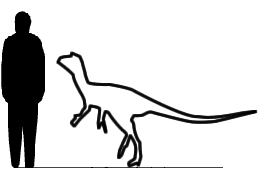[Recent Entries][Archive][Friends][User Info]
| March 18th, 2012 | |
|---|---|
| 04:00 pm [industrialterro] [Link] |
Guaibasaurus Guaibasaurus is an extinct genus of basal dinosaur known from the Triassic of Rio Grande do Sul, southern Brazil. Guaibasaurus was originally named on the basis of the holotype, MCN PV2355, a well-preserved partial postcranial skeleton and the paratype, MCN PV2356, an articulated and nearly complete left hindlimb, which were discovered in the "Sesmaria do Pinhal 2" locality near Candelária, Rio Grande do Sul, in Brazil, in the geopark of Paleorrota. Later, two additional specimens were referred to G. candelariensis: UFRGS PV0725T is an articulated and nearly complete postcranial skeleton missing one forelimb, both feet and the neck, and MCN PV 10112 is still being unprepared block containing articulated parts and some isolated elements of which, including a partial hand. The referred materials were collected from the "Linha São Luiz" locality near the town of Faxinal do Soturno, Rio Grande do Sul, also in the geopark of Paleorrota. All specimen were collected in these two localities from the lower portion of the Caturrita Formation (Rosário do Sul Group, Paraná Basin) or alternatively the uppermost Santa Maria 2 Sequence, dating to the early Norian faunal stage of the Late Triassic, about 216.5-212 million years ago. Specimen UFRGS PV0725T is articulated with hindlimbs tucked underneath its body and forelimbs flexed to the side. Although most of the neck is not preserved, the vertebrae at the base of the neck are present in UFRGS PV0725T and curve to the left, suggesting the entire neck was curved toward the left side of the body. The posture of this skeleton is similar to the resting position of birds, and is otherwise known only from advanced maniraptoran dinosaurs that are closely related to birds. Like living birds, Guaibasaurus may have rested in this position to conserve body heat. José Bonaparte and colleagues, in their 1999 description of the genus, found it to be possible basal theropod and placed it in its own family, Guaibasauridae. Bonaparte and colleagues (2007) found another early Brazilian dinosaur Saturnalia to be very similar to it, and placed the two in the Guaibasauridae which was found to be a primitive saurischian group. Bonaparte found that these forms may have been primitive sauropodomorphs, or an assemblage of forms close to the common ancestor of the sauropodomorphs and theropods. Overall, Bonaparte found that both Saturnalia and Guaibasaurus were more theropod-like than prosauropod-like. However, all more recent cladistic analyses found the members of Guaibasauridae to be very basal sauropodomorphs, except Guaibasaurus itself which was found to be a basal theropod or alternatively a basal sauropodomorph. Guaibasauridae — семейство примитивных ящеротазовых динозавров, известных по ископаемым останкам из позднего триасового периода на территории современных Бразилии и Аргентины. Точный состав и классификация Guaibasauridae остается неопределенной. Семейство первоначально было введено Хосе Бонапартом и его коллегами в 1999 году, тогда содержало один род и один вид — Guaibasaurus candelariensis, и было первоначально причислено к группе тероподов. После второго найденого образца Guaibasaurus, этот динозавр был описан более подробно в 2007 году, что дало возможность сравнить его с другими малоизученными представителями ранних ящеротазовых динозавров, которых часто трудно классифицировать, поскольку они сочетают в себе характеристики двух основных групп ящеротазовых — тероподов и зауроподоморфов. Бонапарт и его коллеги, в свете новой информации, полученной от второго образца, пришли в выводу, что род Saturnalia (который анатомически очень похожи на Guaibasaurus) может быть также отнесен к Guaibasauridae. При дальнейших исследованиях Бонапарт с коллегами обнаружили, что Guaibasauridae обладают большим количеством черт, присущих тероподам, нежели чем черт, присущих ранним зауроподоморфам (или «прозауроподам»). Таким образом, согласно результатам исследований Бонапарта, Guaibasauridae, скорее всего, являются очень ранней базальной группой, находящейся на вершине филогенетической схемы, ведущей к завроподоморфам или группе общих предков зауроподоморфов и тероподов. Кроме того, авторы интерпретируют эти данные, как доказательство того, что общий предок обеих линий ящеротазовых динозавров по внешнему виду был более близок к тераподам, чем к прозауроподам. По классификации M. D. Ezcurra (2010) семейство включает в себя подсемейство Saturnaliinae, содержащее 2 рода — Chromogisaurus и Saturnalia.
Размеры тела в сравнении с человеком:
Tags: Вымершие рептилии, Триас, авеметатарзалии, архозавроморфы, архозавры, диапсиды, динозавроморфы, динозавры, завроподоморфы, тероподы, ящеротазовые |





